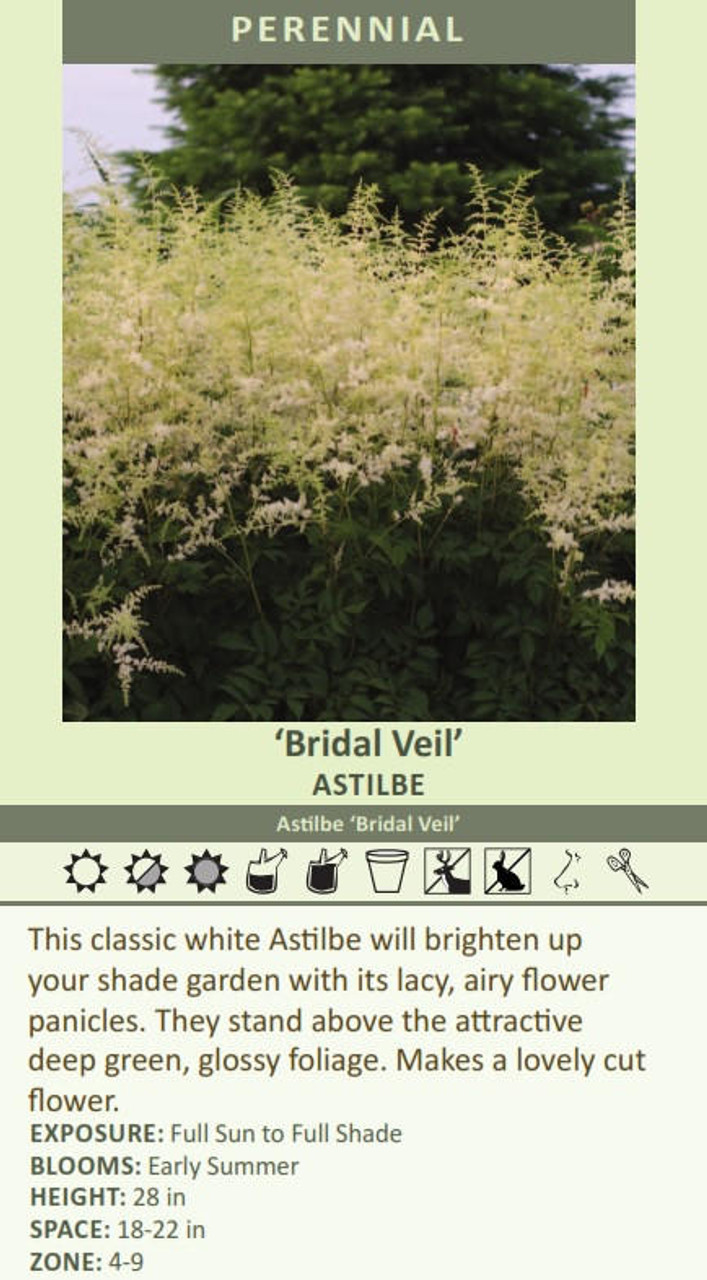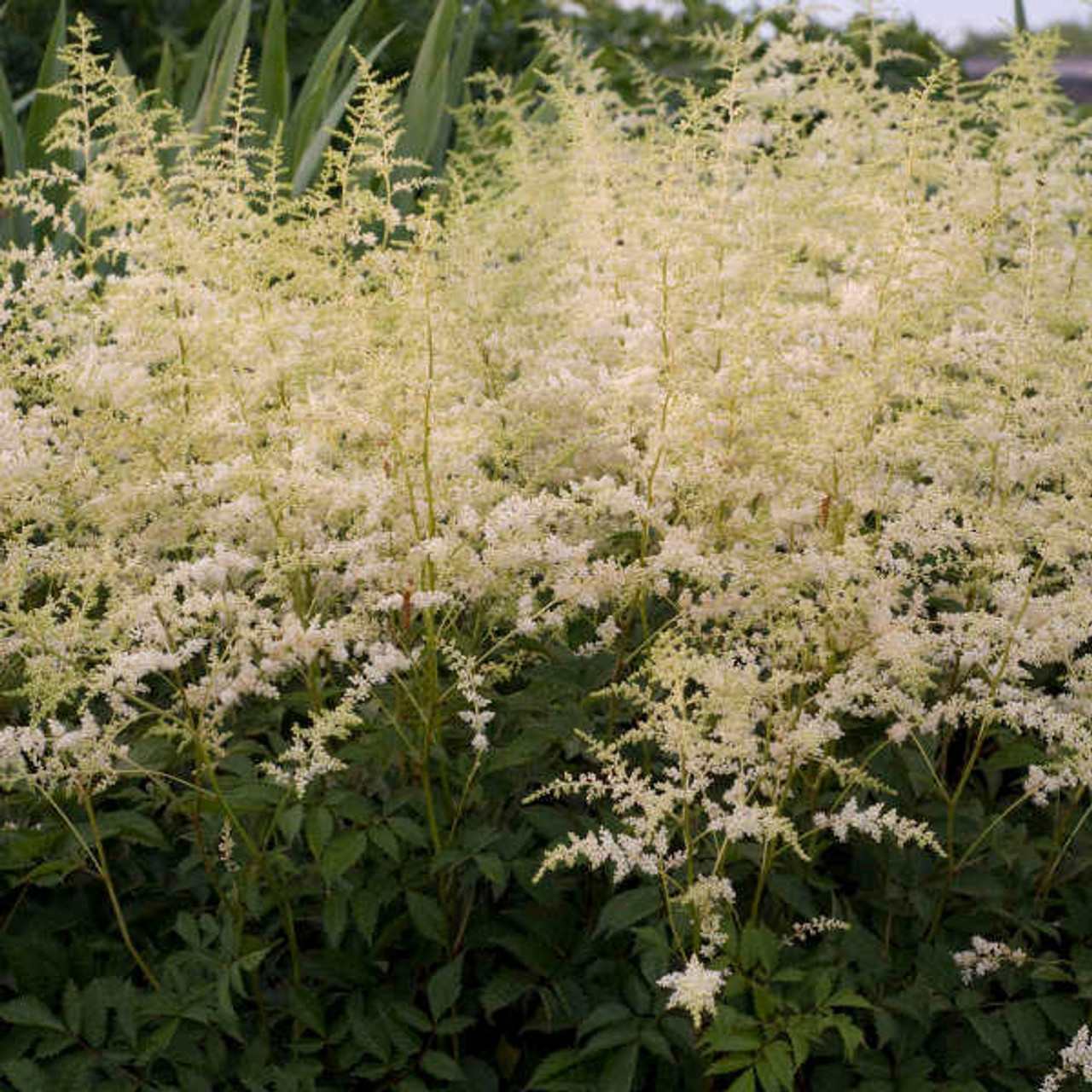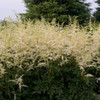Product Description
Astilbe 'Bridal Veil' ('Brautschleier') (25) Bare Root Plants
Common Name: Hybrid Astilbe, False Spirea
Classic lacy, white panicles gently droop at the tips over deep green, glossy foliage. Blooms in early summer. A member of Astilbe x arendsii (Hybrid Astilbe/False Spirea). A group of hybrids developed by famed German nurseryman George Arends. Includes crosses between A. chinensis var. davidii with A. astilboides, A. japonica, and A. thunbergii. The resulting hybrids comprise over 95% of all Astilbe sold in the USA.
Royal Horticultural Society's Award of Garden Merit 1993.
Height: 28.0 Inches
Spread: 18.0-22.0 Inches
Hardiness Zones: 4,5,6,7,8,9
Flower Color: White Shades
Foliage Color: Green shades
Full Sun (> 6 hrs. Direct Sun) to Full Shade (< 4 hrs. Direct Sun)
Average to Consistent Water Needs
Fertile Soil Quality
Bloomtime: Early Summer
Bee Friendly
Deer and Rabbit Resistant
Seasonal Interest: Dried Seed Heads
Growth Rate: Medium, slow spreading, rhizomatous plants
Border Plant, Container, Cut Flower, Cut Foliage, Dried Flower, Fragrant Flowers, Mass Planting
Astilbe 'Bridal Veil' is a classic white astilbe with lacy white panicles that gently droop at the tips, lending a frothy look to the clump. It blooms in early summer and has deep green, glossy foliage. This shade-loving perennial requires moist soils and is deer-resistant, pollinator-friendly, and low maintenance. In this article, we will provide you with all the information you need to successfully grow and care for Astilbe 'Bridal Veil'.
Planting Astilbe 'Bridal Veil' Astilbe 'Bridal Veil' thrives in moist, well-drained soil. It prefers partial shade, especially in hotter climates. When planting, dig a hole that is twice as wide as the root ball and just as deep. Place the plant in the hole and backfill with soil, making sure the crown of the plant is level with the ground. Water thoroughly after planting. To ensure the success of your Astilbe 'Bridal Veil', consider these additional planting tips:
- Soil Preparation: Astilbe thrives in consistently moist soil with a slightly acidic to neutral pH (5.5-7). Amend the soil with compost for added nutrients and to ensure balanced moisture retention and drainage. For optimal growth, a soil mix consisting of 2 parts garden soil, 1 part compost, and 1 part sand is recommended.
- Planting Time: The perfect time for transplanting is during the rejuvenating months of early to late spring.
- Spacing: Space plants at least 16 inches apart to allow ample growing room for the attractive foliage.
Caring for Astilbe 'Bridal Veil' Astilbe 'Bridal Veil' is a relatively low-maintenance plant. However, it does have a few basic needs that must be met to ensure its health and vigor.
- Watering Astilbe 'Bridal Veil' requires consistently moist soil. Water regularly, especially during hot, dry periods. Mulching around the plant can help retain soil moisture. Native to moist woodland settings, Astilbe 'Bridal Veil' thrives in environments that mimic the consistent moisture found in its natural habitat. It prefers evenly moist soil and exhibits moderate drought tolerance once established. For optimal growth, watering every week is recommended to maintain the desired soil moisture levels.
- Fertilizing Fertilize Astilbe 'Bridal Veil' in early spring with a balanced, slow-release fertilizer. You can also supplement with compost or organic fertilizer mid-season to promote vigorous growth. To combat nutrient deficiencies, use a granular or water-soluble liquid fertilizer, and apply it to the soil at about half the recommended dosage. Keep it off the leaves and make sure granular products are watered into the soil well.
- Pruning Deadhead spent flowers to encourage a tidier appearance and prevent self-seeding. Cut back foliage in late fall or early spring to make way for new growth. Astilbes should be pruned in the early spring after the last frost. You can prune off spent flowers to keep your plant looking tidy, but too much pruning late in the season can spur new growth that is delicate and may be killed off by frosts in the fall and winter.
With its beautiful white flowers and lush foliage, Astilbe 'Bridal Veil' is a wonderful addition to any shade garden. By following the simple planting and care instructions outlined in this article, you can enjoy this lovely perennial for years to come.
Other Details
The most important part of the plant is its root system. Healthy roots are the foundation of a healthy, vibrant plant. The type of plug container used is based on the specific needs of the plants. Perennials offered as bare root traditionally perform better when planted as bare root.Planted in a specialized mix, potted plants have well established root systems. Top growth stage will vary depending on the current life cycle and time of year when shipped. In Winter and early Spring dormant plants may be shipped. Dormant plants may be planted right away, even before the last frost date.
Most bare root varieties are field grown for at least one season, though Hemerocallis and Hosta are grown for two seasons. The bulk of the soil is removed during the harvesting process and the tops of most varieties are trimmed back to the crown. They are graded, packed in shredded aspen or sphagnum moss and stored in freezers until ready to be shipped.
See our Container Sizes and Bare Root Perennials pages for more information.
Plant information and care is provided in the Overview section, Plant Genus Page and general information is provided in the Planting Care & Guides. Additional questions can be asked on each Plant page.
Plant Spacing: Using the maximum mature spread or width of a plant to guide spacing, ensures space to grow to full size. To fill an area sooner, plant them closer together. Just remember, future thinning or transplanting may be needed.
Water: Keep a close eye on newly planted perennials, especially throughout the first growing year. Most early plant loss is due to too much or too little water!













